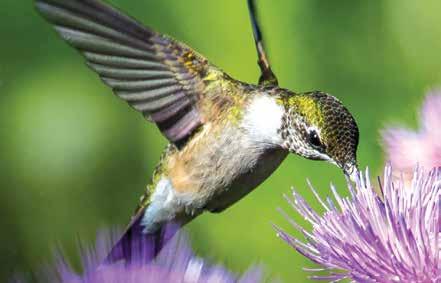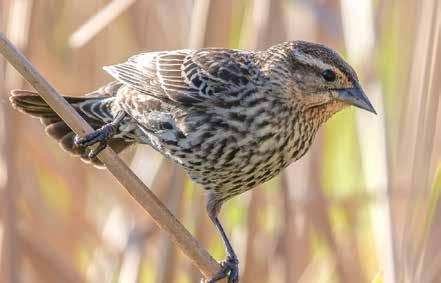
2 minute read
In Praise of Female Birds

Many birders trace their fascination with the feathered tribe to their first encounter with a vibrantly colored, singing spring male. Who can resist the serenade of a red Summer Tanager, a royal blue Indigo Bunting, or a lemon yellow and black goldfinch? But none of these amazing individuals would exist without the efforts of the (often overlooked) other half of the species. Let’s take a moment to appreciate the “superpowers” of female birds.
Females directly influence the characteristics and evolutionary destiny of their species by deciding which males will reproduce. Males invest much time and energy in attracting female attention, using courtship flights and displays, offerings of food and nesting material, and singing. Females generally select experienced males with the brightest plumage, best foraging skills, and the most polished, melodious songs (for some, such as mockingbirds, favored males possess the largest song repertoires).
A songbird’s breeding life is often limited to a few seasons, and some produce only one brood annually. Success means fledging as many healthy chicks as possible, and the female’s choices help determine the productivity of both partners. For example, during bluebird and House Wren courtship, males seek out nest sites and may begin multiple nests—but females ultimately choose their family’s home. Wise site selection, with maximum protection from the elements, reduced chances of predation, and proximity to plentiful food, gives chicks the best chance of survival. Just as males improve their singing and courting abilities with age, females increase their skills at site selection and nest building.
In many backyard birds, such as robins, goldfinches, House Finches, and titmice, the female shoulders all the work of nest building and incubating eggs. A nest takes several days to a week to prepare; materials vary by species. Robins build a sturdy cup of grasses and twigs, with a mud foundation and a lining of soft plant materials. Goldfinches delay nesting until midsummer in order to pad their cup-shaped nests with thistledown. Female orioles spend 10 to 14 days weaving an intricate pouch from strands of grass and plant fibers—usually located near the end of a slender branch where it’s less accessible to predators.
Before incubation can begin, the female produces her clutch. A fully developed egg (produced in about 24 hours) may account for up to 12% of her body weight! Eggs are generally laid singly over several days. Meanwhile, she sheds feathers from her underside, exposing a portion of bare skin known as a “brood patch” that will keep her eggs (and later nestlings) warm. Average incubation time for small songbirds is 12-14 days. Then, several weeks of constant foraging and vigilance is required to raise the chicks to independence.
In species that produce multiple broods, such as cardinals, robins, and bluebirds, the female will often begin a second nest while her mate feeds fledglings from the first.
Both parents often work together to feed nestlings, but the female’s presence is vital during the chicks’ first week of life. Most songbirds are naked at hatching and cannot maintain their own body temperature. Research on bluebirds showed that if the female disappears when the chicks are fewer than 7 days old, they usually die. The male feeds them, but is unable to warm them adequately.
Males assist by defending nests and feeding mates, but nesting is undoubtedly the most vulnerable and perilous time in a female bird’s life. Subdued but attractive colors (like the dull greenish-yellow of a goldfinch or warm brown of an Indigo Bunting) and camouflage patterns (like the brown streaks of House Finches or Red-winged Blackbirds) help both the female








